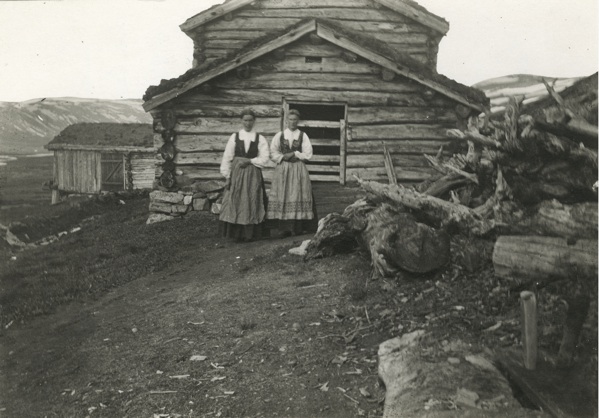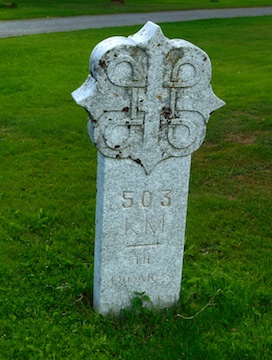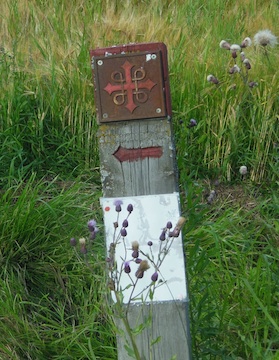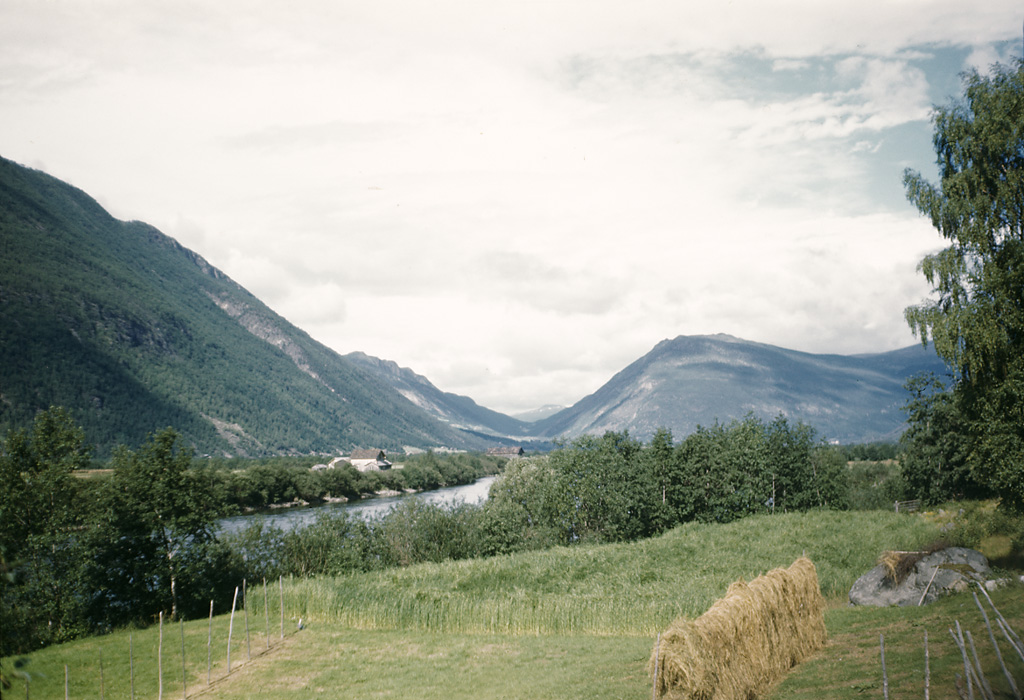
Oppland fields along the Gudbrandsdalslågen river opposite to Hundorp.
photos and panorama, originally 3 photos. Elroy Christenson 2016
Oppland
(Up Land) Norway
A
brief history by Elroy Christenson
Geography
This is a beautiful area of Norway with many farms perched on
hill sides over looking one of various rivers that feed into Lake
Mjøsa. Winter here would have many challenges in terms of
transportation and access to outside communities. Much of
the early history of this region of Norway is covered in ice. The
glaciers carved out the valleys that make up the land, lakes and
rivers that still run through the region. Eight of the ten
highest mountains in Norway are included in the western section of
the county, thus the name the Upper country. These still
snow covered mountains also give the region some major ski areas
where Lillehammer was used as a Winter Olympics area in
1992. The Gudbrandsdalslågen river feeds into Mjøsa lake
which runs for 117 kilometers through the fertile lowlands and is
still the largest lake in Norway with a fjord like depth of up to
1200 feet. The area has signs of human habitation that includes
stone carvings, human remains, and tools along the shore of the
lake and melted out of glaciers which go back to the Stone Age. It
is one of only two counties, including Hedmark, that are land
locked. the farm land is built of glacial till and enriched over
the years with intensive management to be the bread basket of
Norway
[http://www.messagetoeagle.com/glaciersmeltingartif.php]


The Norman conquest of England through the third generation
Viking, William of Normandy "the Conqueror", in 1065-1070 changed
the fate of many. Viking raids ceased for the most part and
Scandinavians retracted into themselves to their farms. They
had expanded over several hundred years to settle in England,
Scotland, Ireland, France, a few colonies in more remote regions
in Russia, and the Mediterranean. The maintenance of these
colonies against the forces in Europe was not sustainable with the
small population of Scandinavia. [Jones]
The authors of this Wikipedia article on the
Birkebinars story fill in some of the gaps in the history,
political intrigue and lay out the tradition for the great
cross-country ski race that is still practiced in Oppland, Norway
each year. The story is about two Birkebeinar skiers who
took the two year old Haakon Haakonsson, heir to the throne, to
safety in the middle of winter. The present contest in March
is one in which each skier of 16,500 must carry "a rucksack"
carrying 3.5 kgs (abt 7.7 lbs) for the 54 km race. (33.4 miles)
ending Lillehammer.
|
teacher of Edvard Munch
[wikipedia.com]
|
The Catholic Church to the Reformation
(900-1537)
Christianity had come to Norway about 900 probably through slaves
brought from England and Europe in raiding parties. It was
not a major player in the minds of the locals until King Olaf/Olav
Haraldsson had tried to impose it on his people. His methods
of conversion were sometimes harsh and brutal. Only after he
is killed at the Battle of Stiklestad was the religion given a
more favorable reception and Olaf was given the title of Saint
Olav. The first archbishop of Scandinavia was established in Lund
Sweden in 1103 and St. Olav is buried somewhere in the Nidoros
Cathedral in Trondheim, Norway. There is a maintained trail
system that goes from Oslo to Trondheim known as St. Olaf's Way
which winds it way through Oppland and Hedmark all the way to
Trondheim. One section in Hedmark goes through the Ringnes farm. A good
portion of the trail goes through Hedmark and the river valleys of
Oppland. They are marked with a cross. Pilgrims honoring St.
Olaf will follow this and get stamps in a special book which is
later turned in to the Headquarter in Trondheim for a certificate
of completion. It is more popular now than it has been for
years.
 |
 |
| St Olaf's Way marker at the
Stange Kirke, Hedmark 503 km. to the Nidaros Cathedral in Trondheim |
St Olaf's Way
a typical marker all over Norway
|
The Reformation was started by the German Catholic monk Martin
Luther who was very offended by the excesses of the Pope Leo X.
Pope Leo X was a member of the Medici family who has supported
Michelangelo's art in Florence and Rome. German was divided into
many small principalities that were often fighting with one
another but some 80% of the land was placed under the control of
the Catholic church while the princes went off to fight in the
Holy Lands and never returned. The remaining princes saw the
Reformation as a way of regaining some control and supported
Luther. King Christian III of Denmark-Norway followed some
of these examples and established the Evangelical-Lutheran church
as the official religion. Changes were made to the rituals,
doctrines and duties. Under Danish control the bible and hymns
were translated into Danish. Monasteries and convents were closed,
the interiors of the churches were white washed to wipe out
paintings of saints and Virgin Marys, statues of saints and
virgins were destroyed and stained glass windows were frequently
broken up. The fact that the population now had the opportunity to
read the Bible for themselves became a major leveler of
Scandinavian culture. The study of reading and writing was frowned
upon by the Catholic Church who saw it as a means of control.
[Church of Norway]
King Christian III (of Denmark) became the head of the official state religion. It continued in as part of the control of the monarchy through 1660. Even with the Norwegian Constitution of 1814 it was confirmed that the Norwegian state would retain "the Evangelical Lutheran religion" as the official state religion. Major religious reform to the organization didn't take place until 1920. Only on 21 May 2012, the Norwegian Parliament passed a constitutional amendment that granted the Church of Norway increased autonomy and no longer called it the "official religion of the State." [Church of Norway]
In 1536 Norway had just gone through the Reformation and the Norwegian Nobility had been diminished by half the numbers and political power. It was also lacking in education for administrative ability. To ensure Danish control the King of Denmark sent Danish noblemen to occupy the needed rolls and urged them to marry landless women or women who lacked noble birth while assuming control of the estates. By this technique the Norwegian nobility line of inheritance was broken and bred out of existence. "After 1536 only 15 percent of Norwegian land was in noble possession" but marriages to landless women further diminished the previous nobility. [wikipedia.org/wiki/Aristocracy_of_Norway]Many of the families that are listed here were
serfs. However, records for the Kråbøl and Bjornstad farm in
Oppland and the Stor-Ree farm in Hedmark lists several families
that lived there for a couple of hundred years each. At this
point I have no historical connection to any of the royal
families, some names are similar to the royal families such as
Eystein, Ragnild, Gulbrand, and of course, Olaf. These could
simply be honorific names not family names. I do have DNA
matches that state that my families have been in northern Europe
for at least 5000 years. I recently have wondered why I have
no DNA related to the present king of Norway but I do have some
DNA similarities to the Swedish king. Historically this
makes sense because the present king of Norway comes from a royal
line out of Germany and Bavaria. Whereas, the Swedish king
comes from a royal lines connected to the kings of Denmark who
controlled Norway for several hundred years. See my own DNA
connections on this page of Elroy's DNA
Analysis and proofs

Gulbrandsdalen Valley, Oppland,
Norway.
Swedish
National
Heritage
Board
@
Flickr Commons, photo by Fredrik Bruno, 1948
Farms in Oppland and associated families.
Sources:






All information and
photos included within these pages was developed by
the help of hundreds of researchers. The information
here is for the express purpose of personal
genealogical research and is freely offered as long as
this site is listed as a source. It may not be
included or used for any commercial purpose or
included in any commercial site without the express
permission of Elroy Christenson. Copyright Elroy
Christenson 1998-2020.